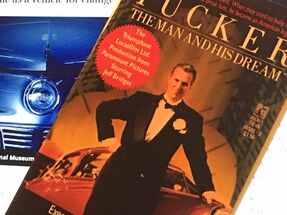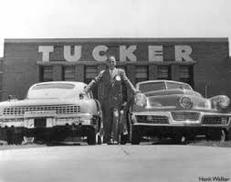
During a neighborhood walk with friends several mornings ago, we got talking about Preston Tucker and his innovative automobile from the late 1940s. Thirty years ago, I had written a client speech on the subject, so went searching through basement files (the old paper kind) ‘til I found it. The subject seemed just as fresh today as it did back then.
It was just after World War II when Preston Tucker, a former policeman, car salesman and engineer/tinkerer, grabbed the future by its collar and shook it. New cars hadn’t been produced since 1942, and the fresh-from-Detroit 1946 models were warmed-over prewar designs. Tucker, however, imagined something radically different, an innovative design that would turn heads and help build the fortune that had always seemed to elude him. His vision of tomorrow’s automobile took shape in the barn back of his house in Michigan, which housed the Ypsilanti Machine & Tool Company where Tucker had designed (but never could bring to market) an armored car, an innovative tank turret and a fighter plane.
He called his prototype the Tucker Torpedo for its daring new shape. It was a revolutionary car. A safe car. A fast car. A fuel-efficient car. A car that could stop on a dime. A car that knocked your eyes out.
The production model Tucker 48 was incredible, although toned down a bit from the prototype. Even so, nobody had ever seen (or imagined) anything this car shaped like the future. It was built low to the ground and featured a windshield wide as a picture window that was designed to pop out in a crash, saving the driver and passenger from popping it out with their heads. It had a third headlight in the center, which pivoted for a better view of the road as the car turned. The 6-cylinder engine, adapted from a helicopter engine, was in the back. It was fuel-injected and there was a double transaxle to drive the rear wheels. The Tucker 48 wasn't clunky looking like most other post-war cars. And wasn't slow, either; it could go 120 mph and had handling and endurance to match. A prototype Tucker ran around a test track for 24 hours and got 25 miles per gallon. When the car was rolled over at 90 mph during a test track run, the driver walked away from the wreck unscathed, and the car was driven away after one tire change. The windshield popped out, just as planned.
People loved the audacious Tucker Torpedo and wanted to buy them (priced at $2,000, when the average new car cost around $1,200). Crowds surrounded the car everywhere Tucker went. Over time, he raised enough money to put together the people and facility to manufacture and market the car, and although his future seemed assured, the Tucker was a failure. Preston Tucker's dream to produce the finest automobile ever made never got to spread its wings, partly because of his own business and financial limitations but also because of crushing political pressure said to have been engineered by the Big Three American auto manufacturers, who perceived the Torpedo as immediate threat to their future. Only fifty-one Tuckers were ever produced.

The "competition” may have helped assure a lack of his cars in our future, but Preston Tucker had something to say about that future. It was a sharp warning for America.
“If big business closes the door to the little guy with new ideas,” he said (quoted in a 1988 film about his life and dream), “we might just as well let the Japanese and the Germans walk in here and tell us what to do. We’re going to wake up one morning and find ourselves at the bottom of the heap instead of being king of the hill. We’ll end up preferring things from outside the country to things that Americans build right here. There will probably come a day when we’ll be buying our cars and radios and appliances from our former enemies.”
People laughed at Preston Tucker’s predictions. They had no concept of a time when American-made automobiles, radios and televisions would nearly be overrun by well-designed, well-made products from Japan and Germany. All they could think about was now. The war was over and heretofore scarce consumer goods had begun reappearing on American shelves. There was a huge demand for new cars as a promising future reached toward the second half of the century. With the demise of Tucker Motor Company, American automakers knew exactly what their near future could have looked like had Tucker’s “car of tomorrow today” succeeded.
There’s a scene in the film where Tucker is in the barn trying to convince his small development team that there was just about enough steel in a tank turret prototype they had laying around from which to build an automobile prototype.
“Can anybody look me in the eye and say we can’t do it?” Tucker challenged.
The prototype did get built, despite Detroit's scheming, and so did fifty more Tuckers. Forty-seven are said to survive today, at least one of which sold not long ago for close to $3-million. The company didn’t make it, however, and the reasons for that remain controversial, but the car was ahead of its time before it left the sketchpad. The mere reason that Preston Tucker tried and almost succeeded gives us reason alone to admire this man who looked fifty years into the future and got to work making things happen.
Takeaway: If you believe your product has enduring marketable value, do everything you can to tell the world about it in a way that it takes hold in your prospects' minds -- and doesn't let go until they become your customers.
Note: This reflection on Preston Tucker and the Tucker Torpedo was adapted from a 1989 client business presentation about Future Perfect Thinking. © 2019 by Brian E. Faulkner

 RSS Feed
RSS Feed